Best coffee grinder 2024 – barista tested for perfect fresh coffee every time
Invest in the best coffee grinder to expand your home brew repertoire when it comes to making espresso, filter coffee, cold brew and more
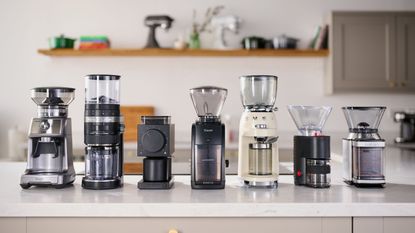

Best coffee grinders 2024: Jump Menu

1. The list in brief ↴
2. Best overall: Fellow Ode
3. Best manual: 1Zpresso JX-PRO
4. Best basic: KitchenAid Burr
5. Best fine grinds: Breville Dose Control
6. Best for precision: Baratza Encore
7. Best budget: Bodum Bistro
8. The ones that just missed the list
9. How to choose
10. How we test
11. Meet the team
Investing in top-quality coffee is just one step to making the perfect cup. It means nothing, however, if you don't grind the beans correctly. Aficionados know that the secret to an incredible cup of coffee always lies in choosing the right ground size for your brew style. And, that can be hard to achieve without having the best coffee grinder to suit.
This is where our team of experts including ex-baristas and home roasters comes in, to help choose the right product for you. We took household brands, such as Breville, Fellow, and Moccamaster to our test kitchen where we put every grinder through its paces.
After testing across a range of beans and types of coffee — we're talking the finest grounds for espresso and consistently coarse grounds for full-bodied French press – we rated and ranked each model. We tried everything from budget-friendly manual grinders to speedy automatic all-in-ones, too.
After bags and bags of beans, and hundreds of cups of coffee, we are sure to have found the perfect grinder for you. So, if you already have the best coffee maker on the market, and want to up your brew game, look no further.
The quick list
If you can't wait, here's a quick summary of our favorite products. We go into more depth and detail of our experiences further down.
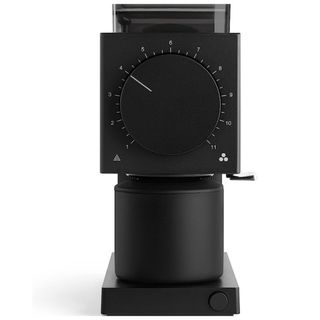
The best coffee grinder overall
Chic and sturdy, this is our favorite grinder for so many reasons. The flat burrs create a flavorful brew without being too loud or too big. Everything about it feels premium.

The best manual grinder
If you're looking for a compact and cordless grinder, this is the one for you. Easy to store and extremely consistent, you can take this with you wherever you go.
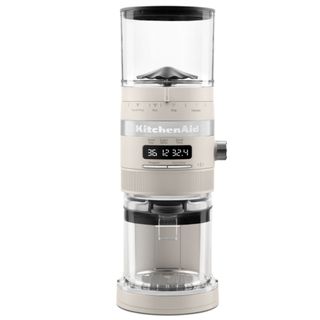
The best for basic grinding
Easy to use and expertly designed, this grinder is extremely consistent. We didn't struggle with static and found it easy to use with a portafilter or grounds container.
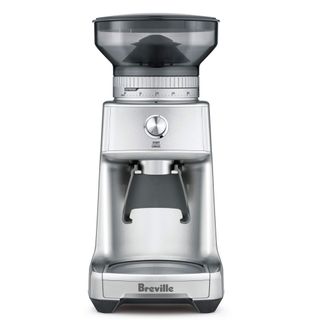
The best for fine grinds
Known for making excellent espressos, this distinctive grinder specializes in fine grinds. If you're a beginner, the pre-set doses are incredibly useful to follow, making for effortless grinding.
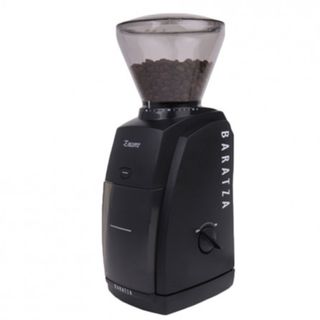
The best for precision
This grinder has one of the lowest grind retentions of all the models we tested. With forty different grind settings and very little static, it's a great buy.

The best under $100
If this is your first grinder, or you're on a budget, this is one of the best buys you'll make. It's a good size and comes with a premium glass grounds container.
The best coffee grinders we recommend in 2024
You can trust Homes & Gardens.
The best coffee grinder overall

1. Fellow Ode Coffee Grinder
Our expert review:
Specifications
Reasons to buy
Reasons to avoid
The Fellow Ode is the most expensive option in this guide, but in our taste-testing, it came out on top in a big way. As the only grinder in this lineup with flat burrs, it’s designed to give a brighter flavor, but won’t always deliver a rich, full-bodied brew.
This weighty coffee grinder is impressively compact. It’s designed to grind single servings at a time, so the hopper is on the small side. Grinding was whisper-quiet and pretty speedy, and with only half-gram retention we experienced minimal loss of our specialist beans. There is also a clearance trigger that will shift any excess grounds stuck inside the unit of the grinder, which is a really nice touch.
Since our initial testing, Fellow has released its Gen 2, with increased grind capacity (100 grams) making it more useful for those of us who brew several cups at once. The new model also has a new bin-loading design, developed anti-static technology for less grind mess, and of course, upgraded burr grinders.
For all that the Fellow Ode can do, it hasn't yet perfected the espresso. If that's what you're looking for, you'll need to try an alternative model.
The best manual coffee grinder

2. 1Zpresso JX-PRO Manual Coffee Grinder
Our expert review:
Specifications
Reasons to buy
Reasons to avoid
If you lack counter space this hand-burr grinder will work well in your home. It's a great compact option that can be stowed in a cabinet or drawer between uses. Don't let its small size give you preconceptions though. When we sifted our ground coffee we were struck by the consistency of this grind, with no major boulders and few fine pieces.
When we taste-tested the range of grinds, each cup of coffee had excellent, long-lasting complexity, but it was the most successful on drip coffee. The flavors were light, bright, and delicious.
The design makes it easy to take anywhere, whether that's in the office or on vacation. This is one of the smallest and slickest grinders on the market and yet it still feels really premium. Given that and the versatility, we highly recommend it to those serious about their coffee.
As the only non-electric grinder in our panel testing, the 1Zpresso JX-PRO Manual Coffee Grinder does have the disadvantage of requiring a little arm strength to get it going, especially if you’re making espresso-ready grounds. Although, this means that the grinding process is slower, producing less heat, so your coffee won't be degraded as it's processed.
The best coffee grinder for basics

3. KitchenAid Burr Coffee Grinder
Our expert review:
Specifications
Reasons to buy
Reasons to avoid
Not well-known among coffee enthusiasts, this KitchenAid Coffee Grinder was a really big surprise. It comes out on top for user experience, with micro-steps that are numbered for easy repeatability, and a user-friendly dial that will guide you when choosing the right setting depending on what coffee you’re making.
We enjoyed the spring-loaded base which held the receptacle flat against the dispenser, resulting in absolutely no spillage. Static was also low, meaning we had no trouble working with our finished grounds. We found that this coffee echoed the notes we would expect from a flat burr grinder, and had an impressive grind consistency when we sifted it.
When we made coffee with the KitchenAid, we were impressed with how well extracted the flavors were. A combination of consistent grinds, good beans, and quality machines left us marveling over every cup of coffee this made. If we had to pick a favorite, it would be the pour-over.
The main drawback with this grinder is the size. If you're not rich in countertop space, there are plenty of other options which are much more compact; the KitchenAid is big.
The best coffee grinder for fine grinds

4. Breville Dose Control Pro Coffee Grinder
Our expert review:
Specifications
Reasons to buy
Reasons to avoid
Breville is known for grinding superfine espresso coffee, so we weren't surprised when this excelled in those parts of our tests. What we didn't expect was how good the Dose Control Pro would be on other coffees; this gave us distinct flavor in our pour-over testing in particular.
The dial on the front has a timer for pre-set doses and it had just over a half of a gram’s retention which is impressive. In testing we defaulted for the middle setting and adjusted depending on how fine our grind was. This one was a lot finer than the other grinders we tested, suggesting it’s set up to make espresso. If you want to make homemade espresso this one is speedy, quiet, and not too static.
When we interviewed barista trainer and coffee expert Alex Spampinato, he recommended this model as his favorite. He said that 'Breville's grinder is super easy to use, so I recommend it to everyone, including beginners. As you develop your barista skills, you realize just how much this grinder has to offer. I still use it now, with 12 years of coffee making behind me.'
It comes with a portafilter holder, but no receptacle for other ground types which is a big shame as it resulted in quite a messy process. There are plenty of beautiful coffee canisters on the market, but for the price of the Dose Control Pro, we wouldn't expect to have to buy extras.
The best coffee grinder for precision

5. Baratza Encore Coffee Grinder
Our expert review:
Specifications
Reasons to buy
Reasons to avoid
We expected to be more impressed with the Baratza Encore, a grinder that’s a well-known option for entry-level coffee enthusiasts. It delivers simplicity and basics, but certainly lacks finesse.
The grind settings go from 0 to 40, so there is no lack of precise options, but we wish we had more guidance on which way increased and decreased the grind size. We had to waste and examine a considerable amount of coffee before we felt confident to use it in our tests. It is a problem you would overcome as you got used to the machine, but a small problem for the manufacturer to solve.
We loved that this grinder had a very low grind retention, only 0.3 grams, and very little static. It wasn’t the quietest of the day though, and we had some popcorning which meant it took longer to grind single doses.
The flavor was a little flat, but we got some brighter middle notes. If you don't go geeky around coffee, you probably wouldn't miss much in your cup. However, our experts are always looking for perfection and this fell a little short.
The best budget coffee grinder

6. BODUM Bistro Premium Electric Grinder
Our expert review:
Specifications
Reasons to buy
Reasons to avoid
BODUM is the best option for a basic, but reliable grind. We found it best to err on the larger side of medium to get a good pour-over grind, because we had a lot of very fine grounds when we went for the true medium setting. This muddied the overall flavor profile, but the coffee was still very drinkable with a fresh taste and light consistency.
We enjoyed the neat dimensions in this grinder, which still came with a generous hopper for batch grinding. The grinder also included a glass receptacle which kept the process quite mess-free.
It was also incredibly straightforward to use. We didn't need any guidance when setting up or using this machine, which is always a treat. If you're new to coffee, this will be easy to navigate using without wasting any coffee or time.
The BODUM was quite noisy in our testing, but this neat little grinder performed very well for the price point. Our biggest grievance was that when we weighed our grounds after grinding, we had over a gram of retention, which isn't ideal.
The ones that just missed the list
If you liked the look of those, but want a few more options, here are the ones that just missed the list. Our experts still loved them, but didn't think they could quite clinch a spot in our top six.
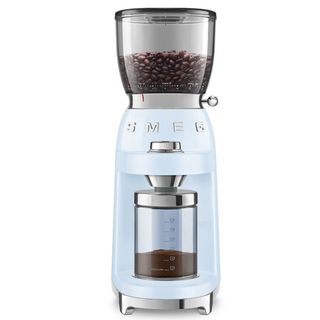
The best for style
In true Smeg style, this delivers on brains and beauty. Whilst it was incredibly consistent on finer grind settings, it was less distinct on coarse grinds. If you like French press, this might be one to swerve. It's also expensive.
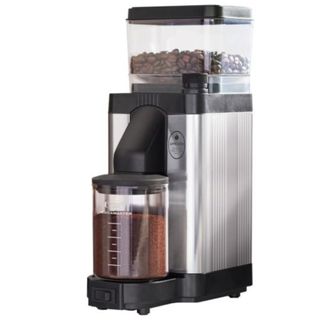
The best for consistency
All about mindful grinding, this sustainably made grinder feels like the real deal. It's sturdy, quick, and quiet. Whilst the upfront cost might look like a lot, it's repairable for life. We wish it had more than nine settings.

The best for budgets
This is the least expensive grinder in our roundup, perfect if you're on a budget. You can batch grind for 32 cups of coffee at once, so it's perfect for efficiency. However, you'll quickly see that it suffers from static and inconsistency.
How to choose the best coffee grinder for you:
Coffee grinders fall into a range of categories. CoffeeFriend CEO Aurimas Vainauskas told us about the different types of coffee grinders on the market. 'Coffee grinders can be put into several different categories based on a few different features. These are the categories you’re likely to encounter:
Manual coffee grinders vs electric coffee grinders
Manual coffee grinders are particularly compact, lightweight and mobile. They’re as convenient to use at home as they are to take with you on a trip. Manual tools are perfect for producing small amounts of ground coffee for various coffee makers or ceramic filters. Not to mention that grinding your beans manually can turn into a beloved daily ritual—and that manual grinders are much cheaper than electric ones! Still, if you’re a sworn fan of espresso, an electric coffee grinder is definitely your best bet. Manual grinders aren’t really suited for grinding beans that finely. Using a manual grinding tool, you won’t be able to grind beans straight into a portafilter either, so your coffee won’t be as fresh as it could be. An electric grinder is a much better solution for those who tend to brew larger amounts of coffee too. It’s suited perfectly for espresso makers and coffee machines, as well as various other brewing tools.
Blade grinders vs burr grinders
Even though blade grinders are still popular nowadays due to their compactness and price, they aren’t really capable of grinding coffee properly. To obtain a consistent grind (and a consistent grind is crucial for a truly delicious, well-balanced brew), you’ll need a burr grinder. There’s no need to throw your old blade grinder out, though: use it to grind spices instead.

A flat burr coffee grinder
Grinders with flat burrs vs grinders with conical burrs
When it comes to burr grinders, they’re divided into two further categories: there are those with flat burrs and those with conical burrs. We can’t really say that one of them is better than the other though. What they do is they unveil different flavors: conical burrs are suited better for traditional espresso (strong and full-bodied), while flat burrs are ideal for the modern take on the classic drink, which is focused on ensuring purity of flavor.
Grinders with ceramic burrs vs grinders with steel burrs
There’s lots of discussion as to which material is better when it comes to burrs, but, again, there’s no right answer. Just like in the case of conical and flat burrs, what this comes down to is subtle differences in flavor. It’s thought that ceramic burrs produce more coffee dust, which endows the brew with a fuller body and ends up “masking” separate flavors. Steel burrs, on the other hand, result in a more consistent grind and a “cleaner” taste. This is why some people believe that ceramic burrs are suited better for traditional espresso and coffee blends, while steel burrs are perfect for modern espresso, filter coffee and specialty coffee varieties.'
How we tested these coffee grinders

Moccamaster and Smeg coffee grinders head to head on test
We take coffee very, very seriously, so when deciding on the best coffee grinder we decided to compare all of the models we tested in a side-by-side test. There are so many factors that can go into making an amazing cup of joe, so we tried to control as many of these as possible in order to make sure that all of the grinders we tested were on a level footing. You can find out more about how we tested the best coffee grinders, and about how Homes & Gardens reviews.
The price of the grinders in this guide ranges from around $60 to over $300, but we were sure to test them fairly and without bias. We tested every possible grind in every grinder, and carried out a blind taste test for each of the drinks we made with the resulting ground beans.
We found that a few of the grinders we expected to come out on top actually fell below some less-expected options. We considered the quality of the coffee, the user experience including noise levels and the feel of the product, and the mess and retention that came with each model.
Meet the team
We had a team of coffee connoisseurs to test the best grinders on the market.

I'm Laura, our e-Commerce editor who was trained as a barista eight years ago. I have been making, drinking, and enjoying coffee ever since. I've spent time with Q-graders, coffee roasters, and other experts in the coffee community. Now, I test and write about all things coffee for us here at Homes & Gardens.

A self-confessed coffee obsessive, when not behind a camera Philip can be found in his garage roasting on a 1.5kg Turkish Drum roaster, which was used to roast a Colombian Pink Bourbon for this grinder test. Sourced from Osito Coffee importers - this coffee was roasted as an “omni” roast suitable for both filter and espresso brewing.
Philip mostly drinks black coffee which he prepares with an aero press and a hand grinder from 1Zpresso - the JX pro. He also enjoys Mokka pot and Clever dripper. For weekends flat whites are on the menu courtesy of a Sage Dual Boiler and a Niche grinder. Philip also owns grinders from MaCap and Santos and previously Eureka, Mazzer and Anfim.
Coffee Grinder FAQs
Do I really need a coffee grinder?
If you're an espresso obsessive, you need a coffee grinder. Fresh-ground coffee is simply better than anything else. Coffee starts to lose its flavors a few hours after grinding, so for the very best, freshest flavors, a coffee grinder is an essential. If you just drink coffee for the caffeine and don't much care about flavor, I wouldn't bother.
Are burr grinders best?
Yes, burr grinders are best. That's because they can achieve a finer, more consistent grind than blade grinders. Blade grinders work like blenders, whizzing up the beans, so need a lot of monitoring to ensure a proper grind. Burr grinders, however, grind beans more consistently, which in turn means a more even shot of espresso.
Why are coffee grinders so expensive?
A good coffee grinder is expensive because it needs quality steel, and in the case of electric grinders, a powerful motor to grind through the coffee. Add in bonus features and you'll find a good grinder is usually around $200.
Sign up to the Homes & Gardens newsletter
Decor Ideas. Project Inspiration. Expert Advice. Delivered to your inbox.

Laura is our eCommerce editor. As a fully qualified barista, she's our expert in all things coffee and has tested over thirty of the best coffee makers on the market. She has also interviewed Q-Graders and world-leading experts in the coffee industry, so has an intimate knowledge of all things coffee. Before joining Homes & Gardens, she studied English at Oxford University. Whilst studying, she trained as a master perfumer and worked in the luxury fragrance industry for five years. Her collection of home fragrance is extensive and she's met and interviewed five of the world's finest perfumers (also known as 'noses'). As a result of this expansive fragrance knowledge, she always puts quality and style over quantity and fads. Laura looks for products which have been designed simply and with thoughtful finishes.
- Millie FenderHead of Reviews
-
 Jennifer Garner ingeniously turned empty space into storage by hiding this kitchen essential in her closet
Jennifer Garner ingeniously turned empty space into storage by hiding this kitchen essential in her closetWhy limit the benefits of an island to the kitchen? Professional organizers urge us to break island conventions, the Garner way
By Megan Slack Published
-
 Modern bedrooms, organized – 8 expert steps to organize a modern sleep space
Modern bedrooms, organized – 8 expert steps to organize a modern sleep spaceProfessional organizers share their tricks for organizing a modern bedroom to keep the space sleek, neat, and optimal for sleep
By Chiana Dickson Published